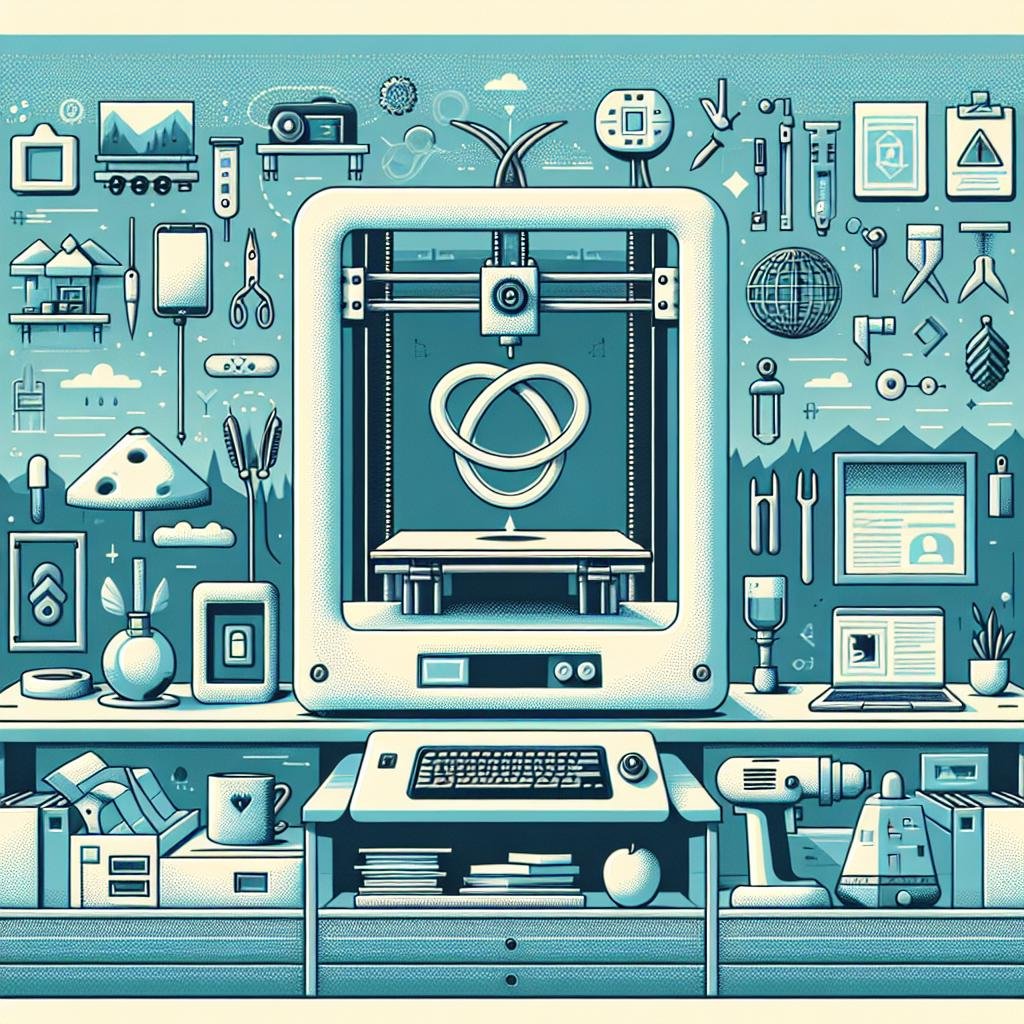Welcome to the world where inventiveness materializes into three dimensions, right from the comfort of your own home! Whether you’re a seasoned 3D printing enthusiast or a curious newcomer, embarking on this creative journey can be both exhilarating and, at times, a bit overwhelming. As the hum of your printer fills the room, transforming digital designs into tangible objects, there’s an undeniable thrill in watching your ideas come to life layer by meticulous layer. However, like any adventurous endeavor, a sprinkle of guidance and a dash of best practices can make all the difference between a seamless creation and a tangled filament fiasco. In this article, we’ll explore the top tips and tricks to refine your home 3D printing experience, ensuring that your creations are not only imaginative but also impeccably crafted. So, gather your tools, brew a cup of patience, and let’s dive into the colorful and ever-evolving realm of 3D printing, where the only limit is the breadth of your imagination.
choosing the Right filament for Your Creations
When it comes to 3D printing at home, selecting the preferable filament can significantly enhance your project outcomes. Your choice will largely depend on the intended function, aesthetic, and environment of your design. PLA is a favorite among hobbyists due to its ease of use and biodegradability, making it fantastic for intricate details and aesthetic pieces. Conversely, ABS is recognized for its sturdiness and resistance to heat, which might be more applicable for functional prototypes or parts. Explore options like PETG, which combines the benefits of both PLA and ABS, offering durability while being easier to print than ABS. Additionally, materials such as TPU for flexible designs or Nylon for more robust requirements could also cater to specific needs. Here’s a speedy look at different filament characteristics:
| Filament | Pros | Best Used For |
|---|---|---|
| PLA | Easy to print, Eco-pleasant | Aesthetic models and prototypes |
| ABS | Heat resistant, Durable | Mechanical parts and toys |
| PETG | Flexible, Tough | Food-safe containers, Durable items |
| TPU | Elastic, Flexible | Phone cases, Wearable items |
To ensure the utmost success in your 3D printing endeavors, consider a couple of factors beyond the basic properties of each filament type. Color and finish can drastically alter the appearance of your final product—available variations include matte, silk, or glitter finishes. Furthermore, it is crucial to account for your printer’s specific capabilities, such as nozzle temperature and bed adhesion solutions.Remember to also factor in post-processing needs; some materials might need to be sanded or painted to achieve your desired finish. Lastly, proper storage measures can’t be overlooked as moisture can degrade the quality of your filament over time. Keep these considerations in mind while experimenting with your projects to nurture creativity and ensure impressive results.

Mastering the art of 3D Printer Calibration
Getting your 3D printer to produce flawless prints can be a bit of an art, but with some fine-tuning, you’ll find precision with ease. Here’s where calibration becomes a pivotal part of your routine. Bed leveling is your starting point; it ensures the nozzle maintains the perfect distance from the bed, crucial for achieving that enviable first layer adhesion. Not leveling your bed can result in a frustrating mix of prints that either drift off target or cling too closely. Adjust the screws or use an auto-leveling sensor to make quick work of this essential task. Additionally, don’t forget the extruder calibration. This simple adjustment ensures the right amount of filament is being fed through your printer, allowing you to avoid blobs or gaps in your prints. Revisiting these elements periodically keeps your 3D printer running smoothly.
You should also pay attention to your material settings, as they can greatly influence the success of your projects. Tweak the nozzle temperature and print speed; each filament type can react differently and finding the sweet spot is key. Remember, manufacturers provide guidelines for these settings, but hitting perfection frequently enough requires a bit of experimentation.Keep a log of your preferred configurations,effectively creating a mini-database to return to. Here’s a handy table to track your settings:
| Filament Type | Nozzle Temperature (°C) | Print Speed (mm/s) |
|---|---|---|
| PLA | 200-220 | 60-80 |
| ABS | 240-250 | 40-60 |
| TPU | 220-240 | 20-30 |
Furthermore, don’t overlook the importance of regular maintenance tasks such as cleaning the nozzle and lubricating the printer’s moving parts. Even the most advanced printers need a bit of care to shine consistently.

Essential Safety Tips for a Hassle-Free Printing Experience
- Workspace Institution: To ensure a seamless printing experience, start by setting up a dedicated space free from clutter. This allows you to manage materials more efficiently and reduces the risk of misplaced items. Clear pathways and obstacle-free zones around your printer improve access and minimize accidents. Organize your tools and materials in labeled containers to find everything at a moment’s notice. Good lighting and a stable,smooth surface for your printer are also crucial to facilitate precise operations and maintenance. A tidy environment not only enhances productivity but also significantly diminishes potential hazards.
- Equipment Checks: Regularly inspect your printer for any signs of wear and tear.Ensure wires and cables are securely connected and that moving parts are lubricated appropriately. Filament Quality is essential; it’s prudent to check the filament for brittleness or moisture damage which can affect print quality and cause damage to your equipment.Investing in a filament storage solution, like sealed containers with desiccants, can drastically improve the longevity and performance of your materials. Never leave a printing job unattended for extended periods, as early detection can prevent minor issues from snowballing into serious malfunctions, such as clogged nozzles or overheating components.
| Checklist | Frequency |
|---|---|
| Lubricate moving parts | Monthly |
| Check filament storage | Every 2 Weeks |
| Calibrate printer Bed | Every Print |

Enhancing Your Printing Technique with Innovative Software Tools
When elevating your at-home 3D printing craftsmanship, integrating cutting-edge software tools can be a game-changer.Modern software offers a treasure trove of options for both novices and seasoned makers, allowing for detailed precision and creativity in your projects. Consider leveraging slicing software which optimizes your design layout, converting 3D models into a language your printer understands. Tools like Cura or PrusaSlicer provide handy features such as layer thickness customization, infill pattern adjustments, and pre-print simulations. Using these, you can predict and refine the print outcome, minimizing errors and material waste.
Another vital software category to explore for seamless 3D printing is modeling and design applications.Programs like Tinkercad, Fusion 360, and Blender allow creators to push the boundaries of what’s possible with their at-home printers. As you design, keep in mind the following tips to enhance output quality:
- Design for Printability: Ensure that your models consider overhangs and requires minimal support structures to save material.
- Scale Appropriately: Adjust designs to fit your printer’s build volume to avoid slicing errors.
- repair Geometry: Use tools like Meshmixer to fix any potential issues in the 3D model before printing.
| Software Tool | Main Feature |
|---|---|
| Cura | Advanced slicing controls |
| Fusion 360 | Parametric design capabilities |
| Meshmixer | Model repair and sculpting |
Q&A
Title: Exploring 3D Printing at home: best Practices Unveiled
Q1: Why should I consider 3D printing at home?
A1: 3D printing at home is like bringing a slice of the future right into your living room! It empowers you to create custom objects, from handy household items to intricate art pieces, all with a dash of creativity and innovation. whether you’re a hobbyist or tech enthusiast, it’s a fantastic way to stretch your creative muscles and transform ideas into tangible realities.
Q2: What essentials do I need to get started with 3D printing at home?
A2: To kickstart your 3D printing journey, you’ll need a reliable 3D printer, suitable filament (PLA is a great beginner-friendly option), a print bed, and design software. don’t forget an adventurous spirit and a curiosity to experiment—those are just as essential!
Q3: How do I choose the right 3D printer for my needs?
A3: Think of a 3D printer like the wand choosing the wizard! Consider the types of projects you want to embark on. For beginners, opt for a user-friendly model that requires minimal assembly. If you’re a tech whiz looking for a challenge, a more advanced machine with customizable settings might be your match. Also,factor in print size,resolution,and budget to find your printing soulmate.
Q4: How do I ensure my 3D prints turn out well?
A4: Crafting perfect prints is an art and a science. Start with leveling your print bed—a level surface is the foundation of a triumphant print. Use quality filament and make sure it’s compatible with your printer.Optimize settings like temperature, print speed, and layer height based on your material. remember, each print is a step towards mastery, so embrace the trial and error!
Q5: what common mistakes should I avoid when 3D printing?
A5: every 3D printing enthusiast has encountered a spaghetti mess of filament at some point! To avoid this, ensure your printer is properly calibrated and your model is designed without unsupported overhangs. Skipping the bed leveling process is another rookie mistake.Lastly, don’t forget to clean your print nozzles regularly—clogs are no one’s freind!
Q6: How do I ensure safety while 3D printing at home?
A6: Safety first, fun second! Ensure your 3D printer is in a well-ventilated area to avoid inhaling fumes. Keep the printing zone free of flammable materials. Always unplug your printer when not in use and use gloves if you’re handling hot items or replacing the filament. With these precautions,you’ll be set for worry-free printing adventures.
Q7: Can you share some creative ideas to print at home?
A7: absolutely! How about designing customized phone stands,quirky plant pots,or intricate jewelry? You could even create personalized cookie cutters for the next baking spree. for tech lovers, try crafting drone parts or Raspberry Pi cases. Let your imagination fly—3D printing is all about turning the impossible into the possible!
Q8: Where can I find inspiration and resources for 3D printing projects?
A8: Dive into the ocean of online resources! Websites like Thingiverse and Cults offer a treasure trove of free designs. Join 3D printing communities on social media to exchange ideas and troubleshoot issues. And don’t overlook YouTube—there’s a tutorial for almost everything under the sun. Happy printing!
—
Embark on your 3D printing adventure with joy and enthusiasm. Remember, every print tells a story, and the best stories come from learning and exploring new frontiers. Happy 3D printing!
Concluding Remarks
As you embark on your 3D printing adventures from the cozy confines of your home, remember that every print is an chance to learn, adapt, and create something extraordinary. Armed with these best practices, you’re not just pressing ‘print’; you’re pioneering a world where imagination meets reality, layer by meticulous layer. Embrace the quirks, celebrate the triumphs, and don’t shy away from a little trial and error. After all, the journey is just as rewarding as the masterpiece taking shape on your print bed. So, fire up your printer, unleash your creativity, and watch as a universe of possibilities unfurls—right at your fingertips. Happy printing!

